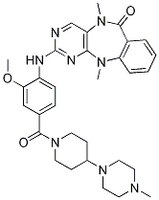438193 Sigma-AldrichLRRK2-IN-1 - CAS 1234480-84-2 - Calbiochem
LRRK2-IN-1, CAS 1234480-84-2, is a cell-permeable, ATP competitive, selective LRRK2 inhibitor (IC50 = 13, 6 & 2.45 µM for WT, G2019S mutant & drug resistant A2016T mutant LRRK2, respectively).
More>> LRRK2-IN-1, CAS 1234480-84-2, is a cell-permeable, ATP competitive, selective LRRK2 inhibitor (IC50 = 13, 6 & 2.45 µM for WT, G2019S mutant & drug resistant A2016T mutant LRRK2, respectively). Less<<Synonyms: LRRK2 Inhibitor I
Recommended Products
-

48-602MAG Millipore MILLIPLEX Cell Signaling Buffer and Detection Kit for Magnetic Beads -

1062230250 Supelco 1-Naphthol -

4805929200 SAFC Hydrochloric acid 10% -

MAB3328 Sigma-Aldrich Anti-MMP-14 Antibody, catalytic domain, clone LEM-2/15.8 -

70584-3 Millipore BugBuster® Protein Extraction Reagent -

967106 Supelco Stainless steel clamp for filling nozzle attachment to stainless steel drums
Overview
Key Spec Table
| CAS # | Empirical Formula |
|---|---|
| 1234480-84-2 | C₃₁H₃₈N₈O₃ |
Pricing & Availability
| Catalogue Number | Availability | Packaging | Qty/Pack | Price | Quantity | |
|---|---|---|---|---|---|---|
| 438193-5MG |
|
Glass bottle | 5 mg |
|
— |
| References | |
|---|---|
| References | Deng, X., et al. 2011. Nat. Chem. Biol. 7, 203. |
| Product Information | |
|---|---|
| CAS number | 1234480-84-2 |
| Form | Yellow-white to pale yellow powder |
| Hill Formula | C₃₁H₃₈N₈O₃ |
| Chemical formula | C₃₁H₃₈N₈O₃ |
| Structure formula Image | |
| Quality Level | MQ100 |
| Biological Information | |
|---|---|
| Purity | ≥95% by HPLC |
| Packaging Information | |
|---|---|
| Packaged under inert gas | Packaged under inert gas |
| Global Trade Item Number | |
|---|---|
| Catalogue Number | GTIN |
| 438193-5MG | 07790788060954 |







